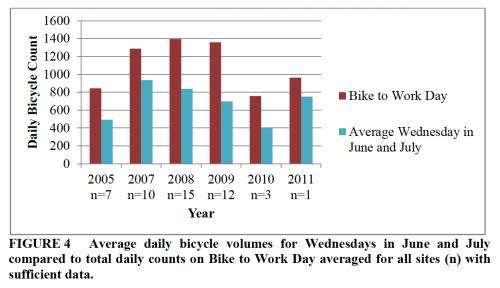Does driving drop when cycling spikes?

The bicycle counts suggested that, on Bike to Work Day, more people did bike to work. But did fewer people drive?
The bike count data from sites across Boulder, Colo., certainly impressed Oregon Transportation Research and Education Consortium staff researcher Krista Nordback. "Bike to Work Day has this huge spike," she said. "The bike counts double at a lot of the count sites.
"Wouldn't it be cool if we could see something similar with the motor vehicle count data?"
In a twist that might only happen in Boulder, with its ample bike counters, Nordback had a harder time tracking down the motor vehicle counts. She lucked out, finding that the city's red-light cameras had been counting cars alongside their primary job of catching red-light runners.
Those motor vehicle counts showed a consistent drop on Bike-to-Work days compared with average workdays in June and July. It was a small drop, but even finding that was unprecedented: no studies had documented a statistically significant drop in motor vehicle counts during any bike-to-work event.
The drops in driving were in the 1-to-2-percent range. Of course, the number of drivers dwarfs the number of cyclists—even in Boulder and even on Bike to Work Days—and any number of factors could affect how many of them drove those days. Nordback had no way to address those factors with the limited data she had.
Same for the number of cyclists during the five years of the event that Nordback studied. They certainly could be switching from driving for those particular days. Of Bike-to-Work-Day participants surveyed by the metropolitan planning organization, 70 percent said they otherwise drove to work.
But there are too many variables left to say that the ranks of cyclists were swollen only with defecting drivers. One is the cultural phenomenon that the event has become. "Bike to Work Day is huge in Boulder," Nordback said. Big enough to draw cyclists out for the related social events and free food who wouldn't have driven to work, or maybe even left the house, otherwise.
So Nordback is measured when she talks about the results. But through all her analyses, the spike in biking and a corresponding drop in driving remains. "It is possible, indeed it seems to be the case, that people chose to bicycle instead of drive that particular day."
More information: The paper, "Measuring Traffic Reduction from Bicycle Commuting," is available here: otrec.us/files/Bike_to_Work_traffic.pdf
Provided by Portland State University


















